Logical Volume Management (LVM)
makes it easier to manage disk space. If a file system needs more space,
it can be added to its logical volumes from the free spaces in its
volume group and the file system can be re-sized as we wish. If a disk
starts to fail, replacement disk can be registered as a physical volume
with the volume group and the logical volumes extents can be migrated to
the new disk without data loss.
In a modern world every Server needs more space day by day for that we need to expand depending on our needs. Logical volumes can be use in RAID, SAN. A Physical Disk will be grouped to create a volume Group. Inside volume group we need to slice the space to create Logical volumes. While using logical volumes we can extend across multiple disks, logical volumes or reduce logical volumes in size with some commands without reformatting and re-partitioning the current disk. Volumes can stripes data across multiple disks this can increase the I/O stats.
2. For Creating a New Volume Group, we need to add Additional 3 hard disks in this server. It is not Compulsory to use 3 Drives just 1 is Enough to create a new VG and LV inside that vg, I am adding more here for demonstration purpose and for more feature command explanations.
Following are the disks I have added additionally.
4. So let’s, create new physical volume (pv), Volume Group (vg) in the name of tecmint_add_vg and create Logical Volumes (lv) in it, Here we can create 4 Logical Volumes in the name of tecmint_documents, tecmint_manager and tecmint_public.
We can extend the Volume Group of currently using VG to get more space. But here, what we are going to do is to Create new Volume Group and play around it, later we can see how to extend the file systems Volume group which is currently in use.
Before using a new Disk we need to partition the disk using fdisk.
In a modern world every Server needs more space day by day for that we need to expand depending on our needs. Logical volumes can be use in RAID, SAN. A Physical Disk will be grouped to create a volume Group. Inside volume group we need to slice the space to create Logical volumes. While using logical volumes we can extend across multiple disks, logical volumes or reduce logical volumes in size with some commands without reformatting and re-partitioning the current disk. Volumes can stripes data across multiple disks this can increase the I/O stats.
LVM Features
- It is flexible to expand the space at any time.
- Any file systems can be installed and handle.
- Migration can be used to recover faulty disk.
- Restore the file system using Snapshot features to earlier stage. etc…
My Server Setup – Requirements
- Operating System – CentOS 6.5 with LVM Installation
- Server IP – 192.168.0.200
Creating LVM Disk Storage in Linux
1. We’ve used CentOS 6.5 Operating system using LVM in a Virtual Disk (VDA). Here we can see the Physical Volume (PV), Volume Group (VG), Logical Volume (LV) by using following command.# pvs # vgs # lvsHere, is the description of each parameters shown in above screenshot.
- Physical Disk Size (PV Size)
- Disk which used was Virtual Disk vda.
- Volume Group Size (VG Size)
- Volume Group name (vg_tecmint)
- Logical Volume name (LogVol00, LogVol01)
- LogVol00 Assigned for sawp with 1GB Size
- LogVol01 Assigned for / with 16.5GB
2. For Creating a New Volume Group, we need to add Additional 3 hard disks in this server. It is not Compulsory to use 3 Drives just 1 is Enough to create a new VG and LV inside that vg, I am adding more here for demonstration purpose and for more feature command explanations.
Following are the disks I have added additionally.
sda, sdb, sdc
# fdisk -l
- Default Disk using for Operating system (Centos6.5).
- Partitions defined in default Disk (vda1 = swap), (vda2 = /).
- Additionally added Disks are mentioned as Disk1, Disk2, Disk3.
- VG Name – A Volume Group name.
- Format – LVM Architecture Used LVM2.
- VG Access – Volume Group is in Read and Write and ready to use.
- VG Status – Volume Group can be re-sized, We can Expand more if we need to add more space.
- Cur LV – Currently there was 2 Logical volumes in this Volume Group.
- CurPV and Act PV – Currently Using Physical Disk was 1 (vda), And its active, so what we can use this volume group.
- PE Size – Physical Extends, Size for a disk can be defined using PE or GB size, 4MB is the Default PE size of LVM. For example, if we need to create 5 GB size of logical volume we can use sum of 1280 PE, Don’t you understand what I’m saying ?.
- Total PE – This Volume Group have.
- Alloc PE – Total PE Used, full PE already Used, 4482 x 4PE = 17928.
- Free PE – Here it’s already used so there was no free PE.
# df -THAbove image shows the mount Point we are using 18GB fully used for root, so there is no free space available.
4. So let’s, create new physical volume (pv), Volume Group (vg) in the name of tecmint_add_vg and create Logical Volumes (lv) in it, Here we can create 4 Logical Volumes in the name of tecmint_documents, tecmint_manager and tecmint_public.
We can extend the Volume Group of currently using VG to get more space. But here, what we are going to do is to Create new Volume Group and play around it, later we can see how to extend the file systems Volume group which is currently in use.
Before using a new Disk we need to partition the disk using fdisk.
# fdisk -cu /dev/sda
- c – Switch off DOS-compatible mode it is Recommend to include this Option.
- u – While listing the partition tables it will give us in sector instead of cylinder.
- Choose n to create new.
- Choose p to create a primary partition.
- Choose which number of partition we need to create.
- Press Enter twice to use the full space of the Disk.
- We need to change the type of newly created partition type t.
- Which number of partition need to change, choose the number which we created its 1.
- Here we need to change the type, we need to create LVM so we going to use the type code of LVM as 8e, if we do not know the type code Press L to list all type codes.
- Print the Partition what we created to just confirm.
- Here we can see the ID as 8e LINUX LVM.
- Write the changes and exit fdisk.
# fdisk -l
Creating Physical Volumes
5. Now, it’s time to create Physical Volumes using all 3 disks. Here, I have listed the physical disk using pvs command, only one default pvs is now listed.# pvsThen create the new physical disks using command.
# pvcreate /dev/sda1 /dev/sdb1 /dev/sdc1Once again list the disk to see the newly created Physical disks.
# pvs
Creating Volume Groups
6. Create Volume Group in the name of tecmint_add_vg using available free PV Create using PE size 32. To Display the current volume groups, we can see there is one volume group with 1 PV using.# vgsThis will create the volume group using 32MB PE size in the name of tecmint_add_vg using 3 Physical volumes we created in last steps.
# vgcreate -s 32M tecmint_add_vg /dev/sda1 /dev/sdb1 /dev/sdc1Next, verify the volume group by running vgs command again.
# vgsUnderstanding vgs command output:
- Volume Group name.
- Physical Volumes used in this Volume Group.
- Shows free space available in this volume group.
- Total Size of the Volume Group.
- Logical Volumes inside this volume group, Here we have not yet created so there is 0.
- SN = Number of Snapshots the volume group contains. (Later we can create a snapshot).
- Status of the Volume group as Writeable, readable, resizeable, exported, partial and clustered, Here it is wz–n- that means w = Writable, z = resizeable..
- Number of Physical Volume (PV) used in this Volume Group.
# vgs -v8. To get more information about newly created volume groups, run the following command.
# vgdisplay tecmint_add_vg
- Volume group name
- LVM Architecture used.
- It can be read and write state, ready to use.
- This volume group can be resizeable.
- No of Physical disk used and they are active.
- Volume Group total size.
- A Single PE size was 32 here.
- Total number of PE available in this volume group.
- Currently we have not created any LV inside this VG so its totally free.
- UUID of this volume group.
Creating Logical Volumes
9. Now, ceate 3 Logical Volumes in the name of tecmint_documents, tecmint_manager and tecmint_public. Here, we can see how to Create Logical Volumes Using PE size and Using GB Size. First, list the Current Logical Volumes using following command.# lvs10. These Logical Volumes are in vg_tecmint Volume Group. List and see how much free spaces are there to create logical volumes using pvs command.
# pvs11. Volume group size is 54GB and its unused, So we can Create LV in it. Let us divide volume group to equal size to create 3 Logical Volumes. That means 54GB/3 = 18GB, A single Logical Volume will be 18GB in Size after Creation.
Method 1: Creating Logical Volumes using PE Size’s
First let us create Logical Volumes Using Physical Extends (PE) size. We need to know Default PE size assigned for this Volume Group and Total PE available to create new Logical Volumes, Run the command to get the info using.# vgdisplay tecmint_add_vg
- Default PE Assigned for this VG is 32MB, Here Single PE size will be 32MB.
- Total Available PE is 1725.
# bc
1725PE/3 = 575 PE. 575 PE x 32MB = 18400 --> 18GBPress CRTL+D to Exit from bc. Let us now Create 3 Logical Volumes using 575 PE’s.
# lvcreate -l (Extend size) -n (name_of_logical_volume) (volume_group) # lvcreate -l 575 -n tecmint_documents tecmint_add_vg # lvcreate -l 575 -n tecmint_manager tecmint_add_vg # lvcreate -l 575 -n tecmint_public tecmint_add_vg
- -l – Creating using Extent Size
- -n – Give a Logical Volume name.
# lvs
Method 2: Creating Logical Volumes using GB Size’s
While Creating Logical Volume using GB size we cannot get the exact size. So, the better way is to create using extend.# lvcreate -L 18G -n tecmint_documents tecmint_add_vg # lvcreate -L 18G -n tecmint_manager tecmint_add_vg # lvcreate -L 18G -n tecmint_public tecmint_add_vg # lvcreate -L 17.8G -n tecmint_public tecmint_add_vgList the Created logical Volumes using lvs command.
# lvsHere, we can see while creating 3rd LV we can’t Round-up to 18GB, It is because of small changes in size, But this issue will be ignored while creating LV using Extend size.
Creating File System
12. For using the logical volumes we need to format. Here I am using ext4 file-system to create the volumes and going to mount under /mnt/.# mkfs.ext4 /dev/tecmint_add_vg/tecmint_documents # mkfs.ext4 /dev/tecmint_add_vg/tecmint_public # mkfs.ext4 /dev/tecmint_add_vg/tecmint_manager13. Let us Create Directories in /mnt and Mount the Logical volumes what we have created file-system.
# mount /dev/tecmint_add_vg/tecmint_documents /mnt/tecmint_documents/ # mount /dev/tecmint_add_vg/tecmint_public /mnt/tecmint_public/ # mount /dev/tecmint_add_vg/tecmint_manager /mnt/tecmint_manager/List and confirm the Mount point using.
# df -h
Permanent Mounting
It’s now temporarily mounted, for permanent mount we need to add the entry in fstab, for that let us get the mount entry from mtab using# cat /etc/mtabWe need to make slight changes in fstab entry while entering the mount entry contents copies from mtab, we need to change the rw to defaults
# vim /etc/fstabOur fstab Entry want to be similar to below sample. Save and exit from fstab using wq!.
/dev/mapper/tecmint_add_vg-tecmint_documents /mnt/tecmint_documents ext4 defaults 0 0 /dev/mapper/tecmint_add_vg-tecmint_public /mnt/tecmint_public ext4 defaults 0 0 /dev/mapper/tecmint_add_vg-tecmint_manager /mnt/tecmint_manager ext4 defaults 0 0Execute the command mount -a to check for the fstab entry before restart.
# mount -avHere we have seen how to setup flexible storage with logical volumes by using physical disk to physical volume, physical volume to volume group, volume group to logical volumes.
Now, we are going to see how to extend volume group, extend and reduce a logical volume. Here we can reduce or extend the partitions in Logical volume management (LVM) also called as flexible volume file-system.
When do we need to reduce volume?
May be we need to create a separate partition for any other use or we need to expand the size of any low space partition, if so we can reduce the large size partition and we can expand the low space partition very easily by the following simple easy steps.My Server Setup – Requirements
- Operating System – CentOS 6.5 with LVM Installation
- Server IP – 192.168.0.200
How to Extend Volume Group and Reduce Logical Volume
Logical Volume Extending
Currently, we have One PV, VG and 2 LV. Let’s list them one by one using following commands.# pvs # vgs # lvsThere are no free space available in Physical Volume and Volume group. So, now we can’t extend the lvm size, for extending we need to add one physical volume (PV), and then we have to extend the volume group by extending the vg. We will get enough space to extend the Logical volume size. So first we are going to add one physical volume.
# fdisk -cu /dev/sda
- To Create new partition Press n.
- Choose primary partition use p.
- Choose which number of partition to be selected to create the primary partition.
- Press 1 if any other disk available.
- Change the type using t.
- Type 8e to change the partition type to Linux LVM.
- Use p to print the create partition ( here we have not used the option).
- Press w to write the changes.
List and check the partition we have created using fdisk.
# fdisk -l /dev/sdaNext, create new PV (Physical Volume) using following command.
# pvcreate /dev/sda1Verify the pv using below command.
# pvs
Extending Volume Group
Add this pv to vg_tecmint vg to extend the size of a volume group to get more space for expanding lv.# vgextend vg_tecmint /dev/sda1Let us check the size of a Volume Group now using.
# vgsWe can even see which PV are used to create particular Volume group using.
# pvscanHere, we can see which Volume groups are under Which Physical Volumes. We have just added one pv and its totally free. Let us see the size of each logical volume we have currently before expanding it.
- LogVol00 defined for Swap.
- LogVol01 defined for /.
- Now we have 16.50 GB size for / (root).
- Currently there are 4226 Physical Extend (PE) available.
For getting the available Physical Extend size run.
# vgdisplayThere are 4607 free PE available = 18GB Free space available. So we can expand our logical volume up-to 18GB more. Let us use the PE size to extend.
# lvextend -l +4607 /dev/vg_tecmint/LogVol01Use + to add the more space. After Extending, we need to re-size the file-system using.
# resize2fs /dev/vg_tecmint/LogVol01
- Command used to extend the logical volume using Physical extends.
- Here we can see it is extended to 34GB from 16.51GB.
- Re-size the file system, If the file-system is mounted and currently under use.
- For extending Logical volumes we don’t need to unmount the file-system.
# lvdisplay
- LogVol01 defined for / extended volume.
- After extending there is 34.50GB from 16.50GB.
- Current extends, Before extending there was 4226, we have added 4607 extends to expand so totally there are 8833.
# vgdisplaySee the result of extending.
# pvs # vgs # lvs
- New Physical Volume added.
- Volume group vg_tecmint extended from 17.51GB to 35.50GB.
- Logical volume LogVol01 extended from 16.51GB to 34.50GB.
Reducing Logical Volume (LVM)
Here we are going to see how to reduce the Logical Volumes. Everyone say its critical and may end up with disaster while we reduce the lvm. Reducing lvm is really interesting than any other part in Logical volume management.- Before starting, it is always good to backup the data, so that it will not be a headache if something goes wrong.
- To Reduce a logical volume there are 5 steps needed to be done very carefully.
- While extending a volume we can extend it while the volume under mount status (online), but for reduce we must need to unmount the file system before reducing.
- unmount the file system for reducing.
- Check the file system after unmount.
- Reduce the file system.
- Reduce the Logical Volume size than Current size.
- Recheck the file system for error.
- Remount the file-system back to stage.
18GB ---> 10GBWhile reducing size, we need to reduce only 8GB so it will roundup to 10GB after the reduce.
# lvsHere we can see the file-system information.
# df -h
- The size of the Volume is 18GB.
- Already it used upto 3.9GB.
- Available Space is 13GB.
# umount -v /mnt/tecmint_reduce_test/Then check for the file-system error using following command.
# e2fsck -ff /dev/vg_tecmint_extra/tecmint_reduce_testNote: Must pass in every 5 steps of file-system check if not there might be some issue with your file-system.
Next, reduce the file-system.
# resize2fs /dev/vg_tecmint_extra/tecmint_reduce_test 10GBReduce the Logical volume using GB size.
# lvreduce -L -8G /dev/vg_tecmint_extra/tecmint_reduce_testTo Reduce Logical volume using PE Size we need to Know the size of default PE size and total PE size of a Volume Group to put a small calculation for accurate Reduce size.
# lvdisplay vg_tecmint_extraHere we need to do a little calculation to get the PE size of 10GB using bc command.
1024MB x 10GB = 10240MB or 10GB 10240MB / 4PE = 2048PEPress CRTL+D to exit from BC.
Reduce the size using PE.
# lvreduce -l -2048 /dev/vg_tecmint_extra/tecmint_reduce_testRe-size the file-system back, In this step if there is any error that means we have messed-up our file-system.
# resize2fs /dev/vg_tecmint_extra/tecmint_reduce_testMount the file-system back to same point.
# mount /dev/vg_tecmint_extra/tecmint_reduce_test /mnt/tecmint_reduce_test/Check the size of partition and files.
# lvdisplay vg_tecmint_extraHere we can see the final result as the logical volume was reduced to 10GB size.
In this article, we have seen how to extend the volume group, logical volume and reduce the logical volume. In the next part (Part III), we will see how to take a Snapshot of logical volume and restore it to earlier stage.

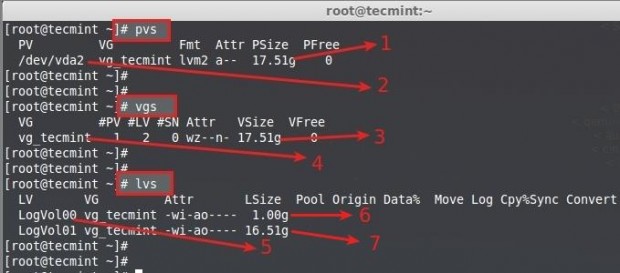
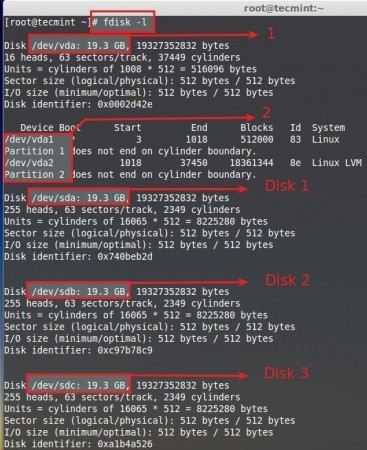
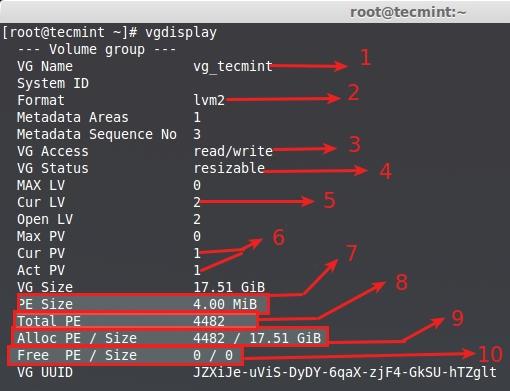

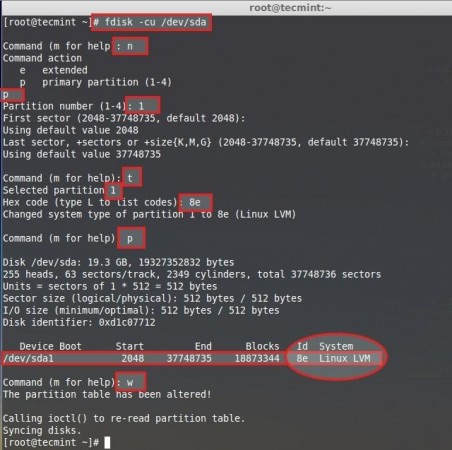
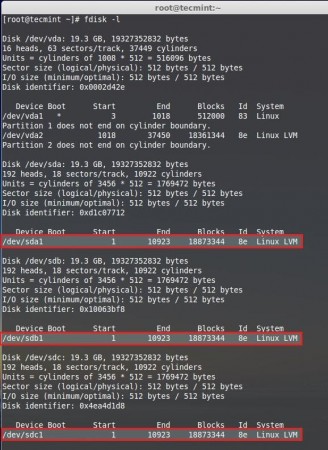
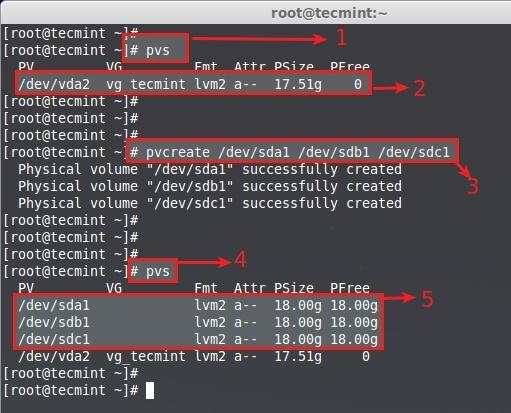
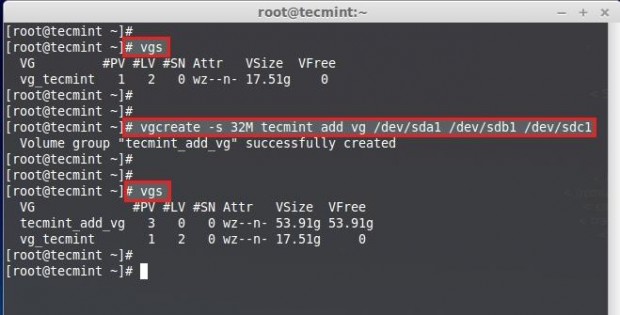
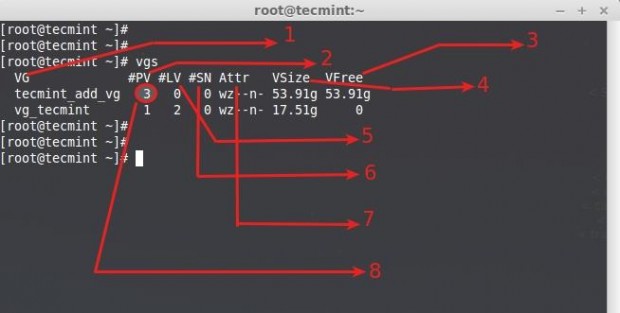

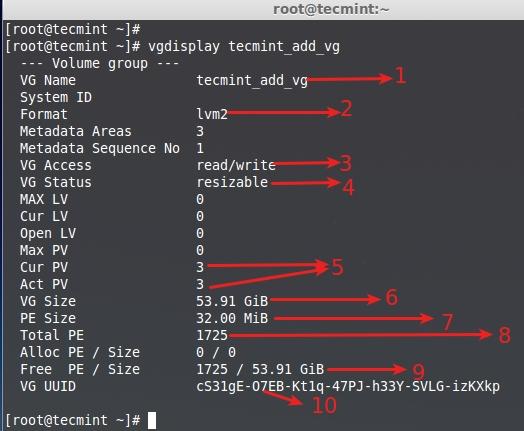



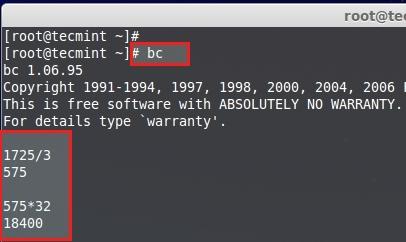
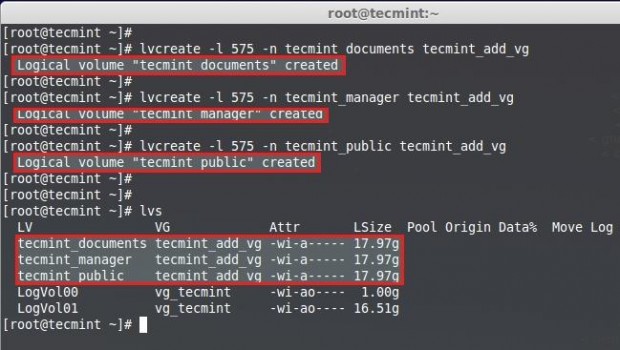
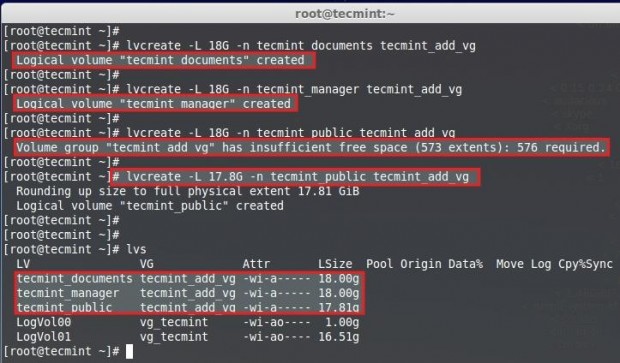
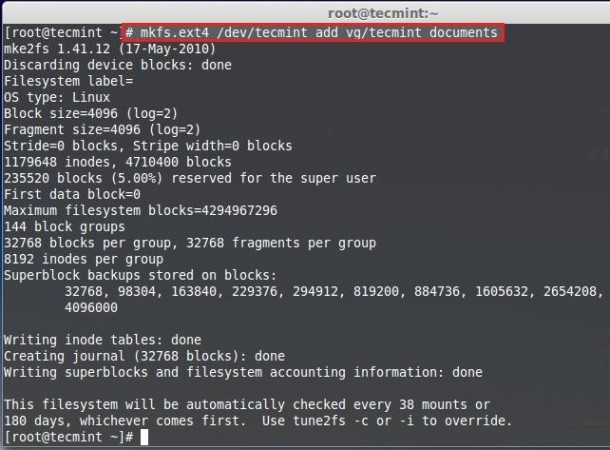
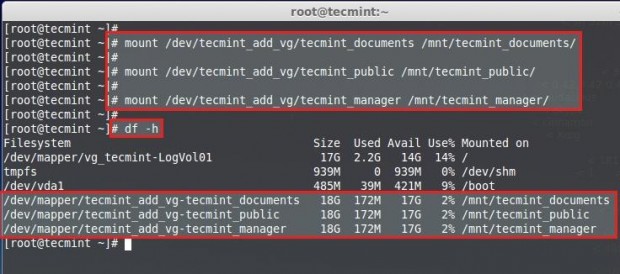
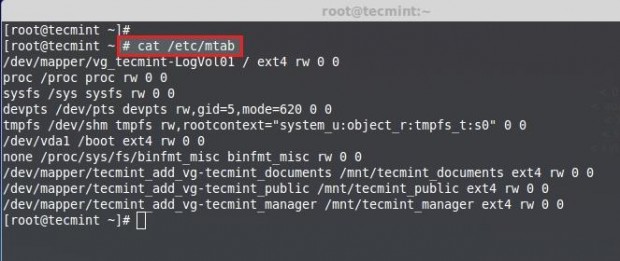

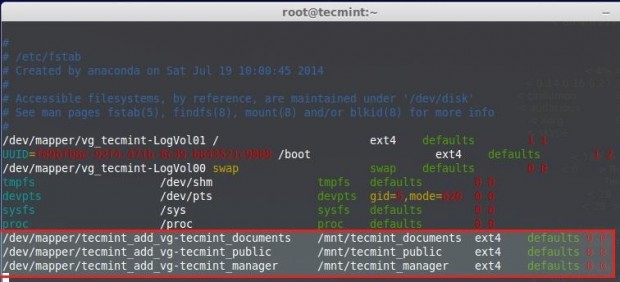

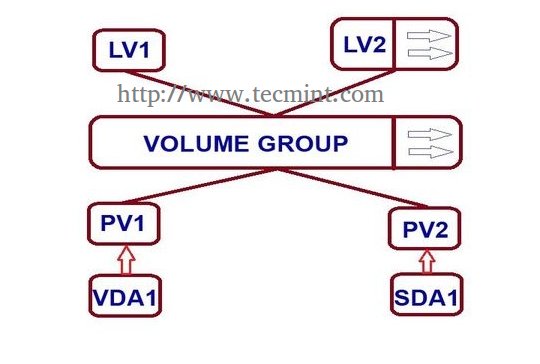

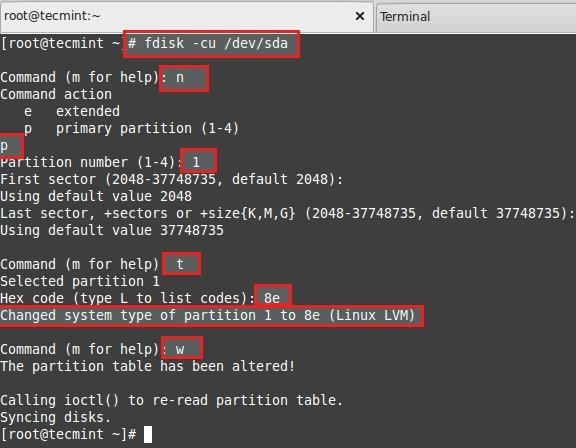
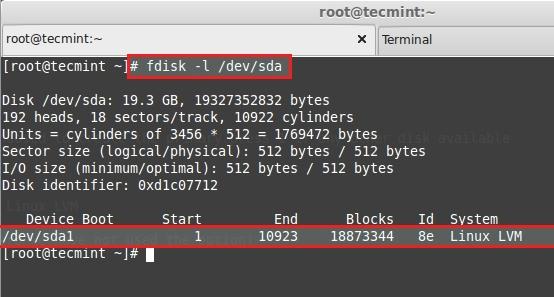
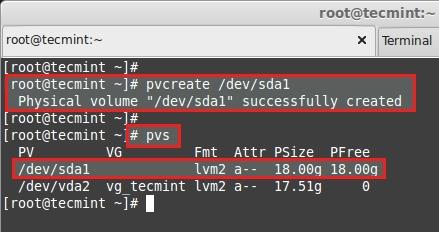
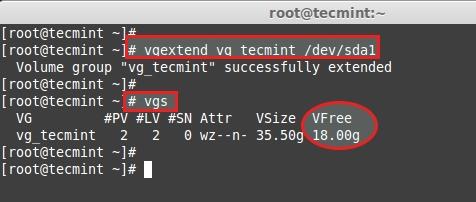

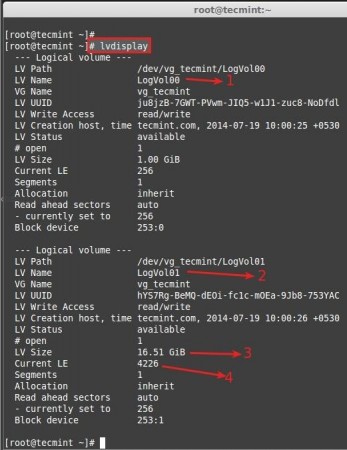
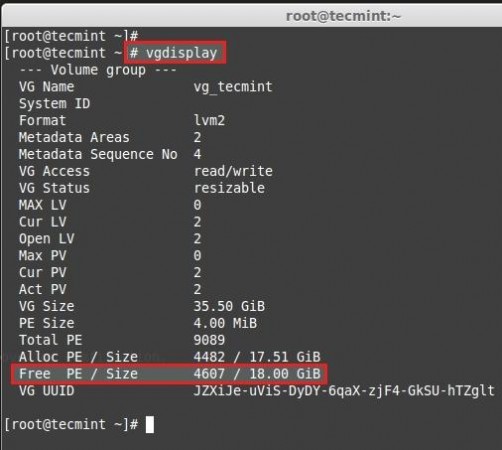
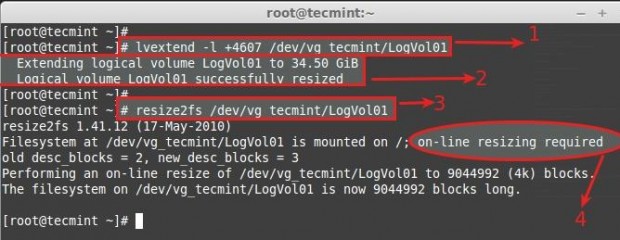
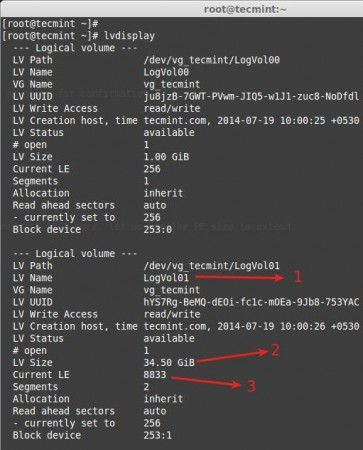




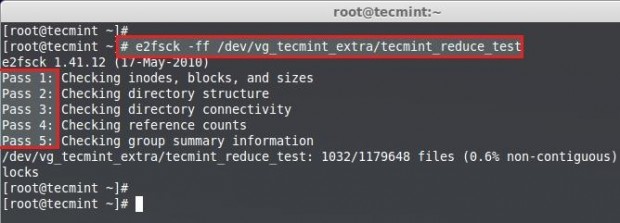







Comentários
Postar um comentário